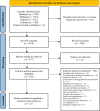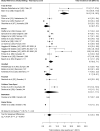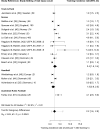Injury Profile in Youth Female Athletes: A Systematic Review and Meta-Analysis
- PMID: 38263483
- PMCID: PMC11127887
- DOI: 10.1007/s40279-023-01988-w
Injury Profile in Youth Female Athletes: A Systematic Review and Meta-Analysis
Abstract
Background: An increasing number of epidemiological studies assessing the incidence, prevalence and severity of injury in youth female sport are available. However, no study has sought to synthesise the current evidence base across all youth female sport. As such, a systematic review and meta-analysis of injury in this cohort is necessary to understand the diversity of injury and its associated burden between sports in addition to identifying the density of research available.
Objective: To conduct a systematic review and meta-analysis of epidemiological data of injuries in youth female athletes with particular attention to injury incidence, mean days lost and injury burden.
Methods: Searches were performed in PubMed, EBSCO (SPORTDiscus with Full Text MEDLINE, APA PsycINFO, CINAHL, Academic Search Complete) and Cochrane databases. Studies were considered if they reported time-loss injury incidence or prevalence in youth female (≤ 19 years old) athletes. Study quality and risk of bias were assessed using STROBE-SIIS extension, Newcastle-Ottawa Scale, and funnel plots, respectively. Injury incidence and burden rate data were modelled using a mixed-effect Poisson regression model. Days lost data were modelled using a generalised linear mixed model.
Results: Thirty-two studies were included. The overall incidence rate, mean days lost per injury, and burden rate were 4.4 injuries per 1000 h (95% CI 3.3-5.9), 10 days (95% CI 6-15), and 46 days per 1000 h (95% CI 23-92), respectively. Forty percent of athletes sustained at least one time-loss injury. Competitive level was a significant moderator of match and training injury incidence, with elite youth athletes presenting greater pooled injury incidence estimates than non-elite athletes (p = 0.0315 and p = 0.0047, respectively). The influence of moderators on days lost and injury burden could not be determined due to an insufficient number of studies for analysis.
Conclusion: Despite a broad inclusion criterion, there is limited injury surveillance research available across youth female sport. Outside of soccer, little research density is evidenced with single studies available in popular team sports such as Australian football and rugby union. Insufficient study numbers reporting mean days lost and injury burden data were available for analysis, and pooled days lost data could only be estimated for soccer. This highlights a need for future research to report days lost data alongside injury number and exposure so burden can be calculated and the full risk of injury to youth female athletes can be identified.
© 2024. The Author(s).
Conflict of interest statement
JB is funded by Leeds Beckett University and the Football Association. The remaining authors have no competing interests to declare.
Figures





Similar articles
-
A systematic review and network meta-analysis on the effectiveness of exercise-based interventions for reducing the injury incidence in youth team-sport players. Part 1: an analysis by classical training components.Ann Med. 2024 Dec;56(1):2408457. doi: 10.1080/07853890.2024.2408457. Epub 2024 Oct 1. Ann Med. 2024. PMID: 39351708 Free PMC article.
-
Incidence and Risk Factors for Sport-Related Concussion in Female Youth Athletes Participating in Contact and Collision Invasion Sports: A Systematic Review.Sports Med. 2025 Feb;55(2):393-418. doi: 10.1007/s40279-024-02133-x. Epub 2024 Dec 8. Sports Med. 2025. PMID: 39645635 Free PMC article.
-
Signs and symptoms to determine if a patient presenting in primary care or hospital outpatient settings has COVID-19.Cochrane Database Syst Rev. 2022 May 20;5(5):CD013665. doi: 10.1002/14651858.CD013665.pub3. Cochrane Database Syst Rev. 2022. PMID: 35593186 Free PMC article.
-
Home treatment for mental health problems: a systematic review.Health Technol Assess. 2001;5(15):1-139. doi: 10.3310/hta5150. Health Technol Assess. 2001. PMID: 11532236
-
Differences in Injury Profiles Between Female and Male Athletes Across the Participant Classification Framework: A Systematic Review and Meta-Analysis.Sports Med. 2024 Jun;54(6):1595-1665. doi: 10.1007/s40279-024-02010-7. Epub 2024 Mar 27. Sports Med. 2024. PMID: 38536647
Cited by
-
The Association Between Psychosocial Factors and Reported Injuries Among Youth Grassroot Soccer Players.Eur J Sport Sci. 2025 Jun;25(6):e12314. doi: 10.1002/ejsc.12314. Eur J Sport Sci. 2025. PMID: 40367323 Free PMC article.
References
-
- Maffulli N LU, Spiezia F, Denaro V. Aetiology and prevention of injuries in elite young athletes. The Elite Young Athlete. 56: Karger Publishers; 2011. p. 187–200. - PubMed
-
- Robles-Palazón FJ, López-Valenciano A, Croix MD, Oliver JL, Garcia-Gómez A, de Baranda PS, Ayala F. Epidemiology of injuries in male and female youth football players: a systematic review and meta-analysis. J Sport Health Sci. 2022;11(6):681–695. doi: 10.1016/j.jshs.2021.10.002. - DOI - PMC - PubMed
Publication types
MeSH terms
LinkOut - more resources
Full Text Sources
Medical
Research Materials

